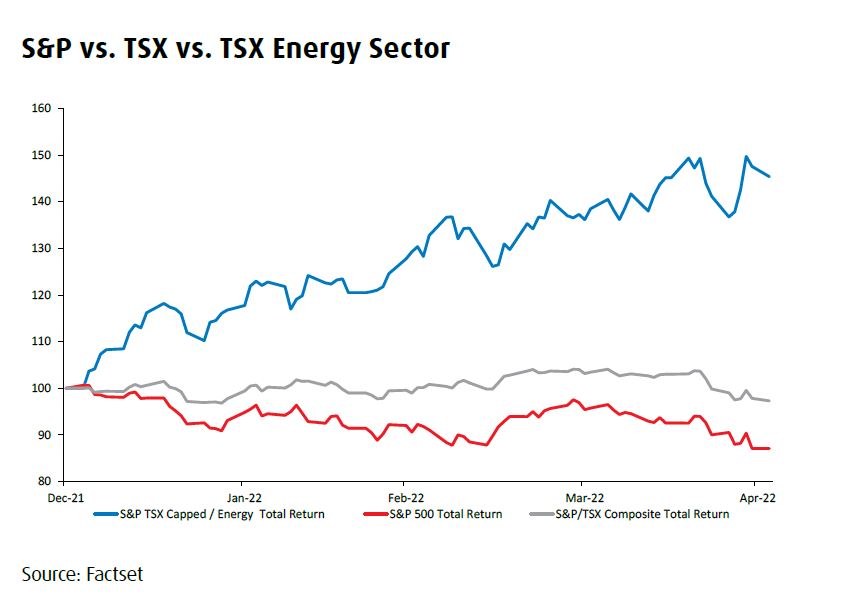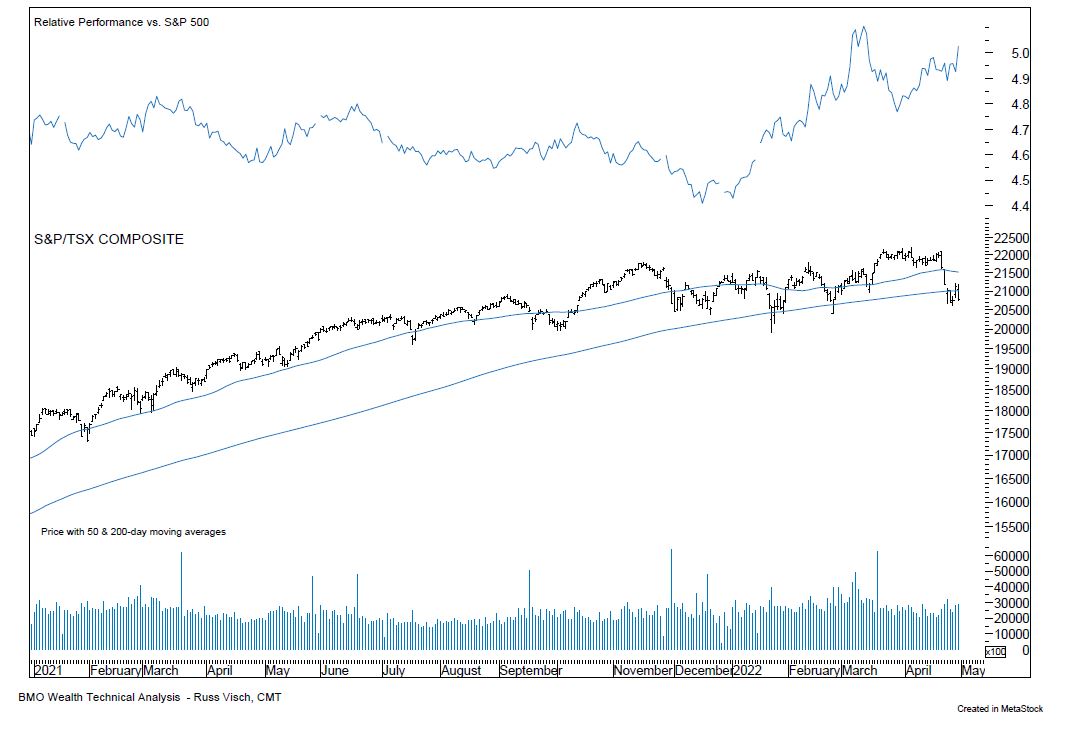Stéphane Rochon, CFA, Equity Strategist
Richard Belley, CFA, Fixed Income Strategist
Let’s say it like it is. North American Central Banks have painted themselves into a corner by leaving interest too low for too long. This is what is commonly known as “ultra-easy monetary policy” in the parlance of Bay Street. Well, those days are now behind us judging by the increasingly blunt rhetoric from Central Bankers. To wit, Fed Chairman Powell recently said that inflation would stay high in 2022, but he vowed the central bank will do whatever it takes to bring price increases under control. His Bank of Canada (BoC) counterpart Tiff Macklem admitted to misjudging the strength of inflation at the start of the year and pledged to act “as forcefully as needed” to make up for the mistake. Little wonder interest rates have been rising.
The stock and bond markets have taken notice with unabated volatility so far in the first half of 2022. Government bonds just posted their worst quarterly performance on record, while the S&P 500 and Nasdaq have taken big hits of late. No category of securities has been harder hit than very expensive tech stocks and other so called “high duration” equities (i.e., stocks that get the bulk of their value from projected future growth in cash flows)1.
Being Selective
The silver lining is that over a long period, stocks have always been and will remain the asset class of choice to help investment portfolios withstand the ravages of inflation. So, liquidating stocks in the face of increased volatility is never the optimal long-term strategy. However, being selective in our geographic, sector and company allocation is critical. In this environment we continue to emphasize quality companies with large competitive advantages which provide enough pricing power to offset their own cost increases and protect their profit margins. We strongly advise investors to be especially sensitive to valuations (i.e., do not overpay for stocks) as there are still many technology/communications stocks which we consider overvalued despite significant declines.
S&P/TSX Composite Well Positioned
Canadian investors also have grounds for optimism in our view, and we see room for the S&P/TSX Composite (“TSX”) to continue outperforming. This is due to the Canadian market’s composition which is well suited to withstand inflation. In fact, we have a far higher proportion of Energy and Basic Materials stocks which tend to do very well in this type of macro environment, and our market still trades at an attractive discount to the S&P 500. The unprovoked Russian aggression has also accelerated a number of trends (e.g., higher energy, grain and metal prices, of course), and forced a fundamental rethink of energy policies in Western Europe. In other words, finding alternative energy and materials suppliers has become of paramount importance and Canada just happens to have massive reserves of those things.
Market action seems to support this opinion as there has been a very wide variance in performance across different sectors. The chart below shows that year-to-date the S&P 500 is down 13% (former tech highflyer Netflix is down over 60%). Conversely, the TSX is almost flat this year and the Canadian Energy sector is showing a gain of almost 45%.

Canadian Economy Outperforming
Importantly, BMO’s Chief Economist Doug Porter recently stated that, “amid this dreary [global] growth backdrop, one economy is quietly going the other way. In what may well be a first for 2022, we have revised up a GDP estimate—for none other than Canada. Growth came in even better than the initial take for February, and March’s flash read was also solid, pointing to Q1 annualized growth of 5.5%. As a result, we now see the economy growing by just over 4% this year, versus 3.5% previously, and maintaining a sturdy 3% pace next year—both well in excess of potential growth of less than 2%”.
What explains this counter-move by the Canadian economy? One readily obvious explanation is that Canada produces much of what Russia produces, and has seen its basket of resource prices roar. The Bank of Canada’s commodity price index, for example, is up 28% just since the start of the year. A little less obvious is the fact that, with the loonie largely treading water this year, this commodity surge has turned into a bonanza for producers. In Canadian dollar terms, the BoC’s index is off the charts, and nearly double the median level of the past 20 years.
Market Technicals
Our Technical Analyst Russ Visch notes that the TSX has come under pressure over the past two weeks, but his work suggests this slide is likely very near to ending. For example, by the middle of last week the TSX was more oversold on a short-term basis than at any point in the past two years. In fact, we’ve only seen three instances since the beginning of 2020 where the TSX was pushed into deep oversold levels like this and in each case it represented a major trading low. It’s also important to note that the TSX continues to outperform its U.S. counterparts since most of the weakness has been concentrated in the mega-cap technology names.
The TSX has sold off very recently but continues to consistently outperform the S&P 500.

While the environment could remain volatile for some time and more downside is possible, the key is to stay disciplined about the price paid for any assets and to maintain a well-diversified portfolio including cash, bonds, and high-quality stocks. Please contact your BMO financial professional if you would like to discuss your investment portfolio.
1Higher inflation erodes purchasing power and pushes interest rates higher. This, in turn, lowers the present value of future corporate free cash flows (which is in essence the fair value for stocks). The more investors believe these cash flows will grow in the future, the more those stocks are negatively impacted by this effect.
General Disclosure
The information and opinions in this report were prepared by BMO Nesbitt Burns Inc. Portfolio Advisory Team (“BMO Nesbitt Burns”). This publication is protected by copyright laws. Views or opinions expressed herein may differ from the views and opinions expressed by BMO Capital Markets’ Research Department. No part of this publication or its contents may be copied, downloaded, stored in a retrieval system, further transmitted, or otherwise reproduced, stored, disseminated, transferred or used, in any form or by any means by any third parties, except with the prior written permission of BMO Nesbitt Burns. Any further disclosure or use, distribution, dissemination or copying of this publication, message or any attachment is strictly prohibited. If you have received this report in error, please notify the sender immedi¬ately and delete or destroy this report without reading, copying or forwarding. The opinions, estimates and projections contained in this report are those of BMO Nesbitt Burns as of the date of this report and are subject to change without notice. BMO Nesbitt Burns endeavours to ensure that the contents have been compiled or derived from sources that we believe are reliable and contain information and opinions that are accurate and complete. However, BMO Nesbitt Burns makes no representation or warranty, express or implied, in respect thereof, takes no responsibility for any errors and omissions contained herein and accepts no liability whatsoever for any loss arising from any use of, or reliance on, this report or its contents. Information may be available to BMO Nesbitt Burns or its affiliates that is not reflected in this report. This report is not to be construed as an offer to sell or solicitation of an offer to buy or sell any security. BMO Nesbitt Burns or its affiliates will buy from or sell to customers the securities of issuers mentioned in this report on a principal basis. BMO Nesbitt Burns, its affiliates, officers, directors or employees may have a long or short position in the securities discussed herein, related securities or in options, futures or other derivative instruments based thereon. BMO Nesbitt Burns or its affiliates may act as financial advisor and/or underwriter for the issuers mentioned herein and may receive remuneration for same. Bank of Montreal or its affiliates (“BMO”) has lending arrangements with, or provides other remunerated services to, many issuers covered by BMO Nesbitt Burns’ Portfolio Advisory Team. A significant lending rela¬tionship may exist between BMO and certain of the issuers mentioned herein. BMO Nesbitt Burns Inc. is a wholly owned subsidiary of Bank of Montreal. Dissemination of Reports: BMO Nesbitt Burns Portfolio Advisory Team’s reports are made widely available at the same time to all BMO Nesbitt Burns investment advisors. Additional Matters TO U.S. RESIDENTS: Any U.S. person wishing to effect transactions in any security discussed herein should do so through BMO Capital Markets Corp. (“BMO CM”) and/or BMO Nesbitt Burns Securities Ltd. (“BMO NBSL”) TO U.K. RESIDENTS: The contents hereof are intended solely for the use of, and may only be issued or passed onto, persons described in part VI of the Financial Services and Markets Act 2000 (Financial Promotion) Order 2001.
BMO Private Wealth is a brand name for a business group consisting of Bank of Montreal and certain of its affiliates in providing private wealth management products and services. Not all products and services are offered by all legal entities within BMO Private Wealth. Banking services are offered through Bank of Montreal. Investment management, wealth planning, tax planning, and philanthropy planning services are offered through BMO Nesbitt Burns Inc. and BMO Private Investment Counsel Inc. If you are already a client of BMO Nesbitt Burns Inc., please contact your Investment Advisor for more information. Estate, trust, and custodial services are offered through BMO Trust Company. BMO Private Wealth legal entities do not offer tax advice. BMO Trust Company and BMO Bank of Montreal are Members of CDIC.